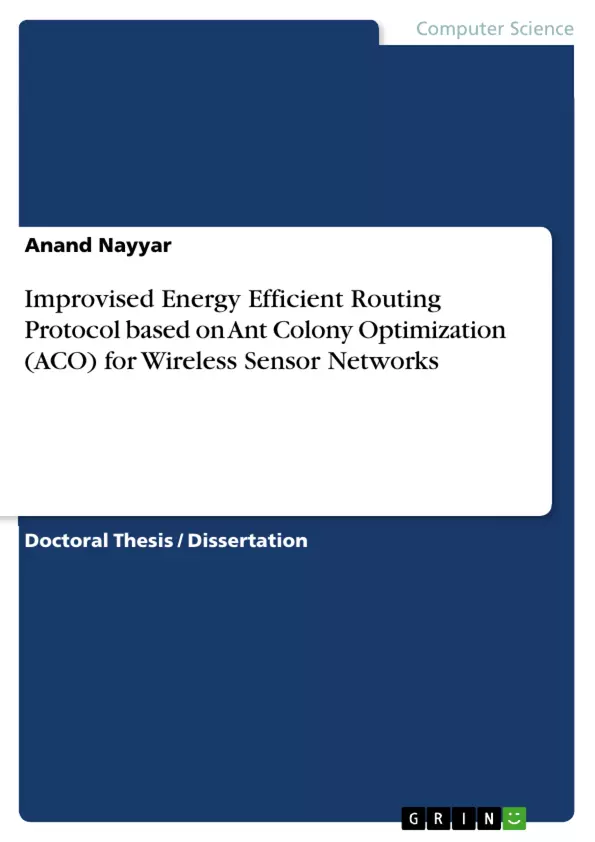Routing and Energy Efficiency is regarded as highly challenging area of Sensor networks. Significant advancements in Wireless Sensor Networks (WSNs) opens doors for wide implementation in real-time applications like Industrial Monitoring, Smart Cities development, Underwater monitoring operations, tracking objects and many more. Energy Efficient routing is regarded as the most challenging task. Sensor networks mostly operate in complex and dynamic environments and routing becomes tedious task to maintain as the network size increases. Lots of routing protocols- Reactive, Proactive and Hybrid are proposed by researchers but every protocol faces some limitations in terms of energy, routing, packet delivery ratio and security. Therefore, to overcome all the routing issues, the trend has shifted to Biological based Algorithms like Swarm Intelligence based techniques. Ant Colony Optimization based routing protocols have demonstrated exceptional results in terms of performance when applied to WSN routing.
This thesis outlines routing protocols in sensor networks, highlight the concept of Swarm Intelligence and presents various Ant Colony Optimization based routing protocols for sensor networks. In addition to this, we present Ant Colony based Energy Efficient routing protocol (IEEMARP = Improvised Energy Efficient Multipath Ant Based Routing Protocol) for sensor networks. The proposed protocol takes into consideration various performance metrics like Packet Delivery Ratio, Throughput, Energy Efficiency, Routing Overhead and End-to-End delay. Proposed protocol is simulated and tested using NS-2.35 simulator. Simulation based results stated that IEEMARP routing protocol is overall 16% more efficient in terms of Packet delivery ratio, Energy Efficiency, Throughput, Routing Overhead and End-to-End delay as compared to other ACO based routing protocols. In addition to this, IEEMARP is highly reliable protocol to ensure timely delivery with acknowledgement packet exchange between source node to sink node and vice versa and also combats the issue of congestion and packet dropping to large extent.
Inhaltsverzeichnis (Table of Contents)
- Chapter 1: Introduction
- 1.1 Sensor Networks- Evolution and Introduction
- 1.2 Model of Wireless Sensor Network
- 1.3 Wireless Sensor Networks- Design Principles and Challenges
- 1.4 Wireless Sensor Networks - Types
- 1.5 Wireless Sensor Networks- Classifications
- 1.6 Wireless Sensor Network Architecture: Protocol Stack
- 1.7 Routing in Wireless Sensor Networks
- 1.7.1 Challenges connected to Routing in Wireless Sensor Networks
- 1.7.2 Classifications of Routing Algorithms/Protocols
- 1.8 Swarm and Swarm Intelligence (SI)
- 1.9 Ant Colony Optimization (ACO)
- 1.9.1 Introduction
- 1.9.2 Ants in Nature
- 1.9.3 Ants Stigmergic behavior
- 1.9.4 Real Ants v/s. Artificial Ants
- 1.9.5 Ant Colony Optimization Metaheuristic
- 1.9.6 Mathematical Model of Ant Colony Optimization
- 1.9.7 Components of Ant Colony Optimization (ACO)
- 1.9.8 Ant Colony Optimization Algorithms
- 1.9.8.1 Ant System Algorithm
- 1.9.8.2 Ant Colony System (ACS)
- 1.9.8.3 MAX-MIN Ant System
- 1.9.8.4 Ant Lion Optimizer
- 1.9.9 Ant Colony Optimization- Working and Algorithm
- 1.10 Suitability of Ant Colony Optimization (ACO) based approach for Developing Energy Efficient Routing Protocols for Wireless Sensor Networks
- 1.11 ACO Based Routing Protocols for Wireless Sensor Networks
- 1.11.1 Sensor Driven Cost-Aware Ant Routing (SC)
- 1.11.2 Energy Efficient Ant Based Routing (EEABR)
- 1.11.3 Flooded Forward Ant Routing (FF)
- 1.11.4 Flooded Piggyback Ant Routing (FP)
- 1.11.5 Energy-Delay Ant Based (E-D Ants)
- 1.11.6 Ant Colony Based Reinforcement Learning Algorithm (AR and IAR)
- 1.11.7 Basic Ant Based Routing (BABR) for Wireless Sensor Networks (WSN)
- 1.11.8 Ant Based Quality of Service Routing (ACO-QoSR)
- 1.11.9 Ant Colony Optimization based Location-aware Routing (ACLR)
- 1.12 Energy Efficient Routing Protocols based on Ant Colony Optimization for Wireless Sensor Networks
- 1.12.1 Ant Chain Protocol
- 1.12.2 Ant Aggregation
- 1.12.3 Pheromone Based Energy Aware Directed Diffusion (PEADD)
Zielsetzung und Themenschwerpunkte (Objectives and Key Themes)
This thesis focuses on the challenging area of routing and energy efficiency in Wireless Sensor Networks (WSNs). It explores various routing protocols, highlighting the benefits of Swarm Intelligence, particularly Ant Colony Optimization (ACO), for addressing energy efficiency challenges in these networks.
- Examining the evolution and design principles of WSNs
- Investigating the challenges related to routing and energy efficiency in WSNs
- Exploring the concepts of Swarm Intelligence and ACO, including their suitability for WSN routing
- Presenting and analyzing existing ACO-based routing protocols for WSNs
- Proposing a novel energy-efficient routing protocol based on ACO for WSNs.
Zusammenfassung der Kapitel (Chapter Summaries)
Chapter 1 provides a comprehensive introduction to Wireless Sensor Networks, covering their evolution, design principles, types, classifications, architecture, and the challenges associated with routing. The chapter also delves into the concepts of Swarm Intelligence and Ant Colony Optimization, exploring their potential for addressing WSN routing issues. It further presents a review of existing ACO-based routing protocols for WSNs.
Schlüsselwörter (Keywords)
The primary keywords and focus topics of this work include Wireless Sensor Networks (WSNs), routing protocols, energy efficiency, Swarm Intelligence, Ant Colony Optimization (ACO), packet delivery ratio, throughput, routing overhead, and end-to-end delay. The research explores the application of ACO-based algorithms for developing efficient and reliable routing solutions for WSNs.
- Quote paper
- Anand Nayyar (Author), 2017, Improvised Energy Efficient Routing Protocol based on Ant Colony Optimization (ACO) for Wireless Sensor Networks, Munich, GRIN Verlag, https://www.grin.com/document/385058



